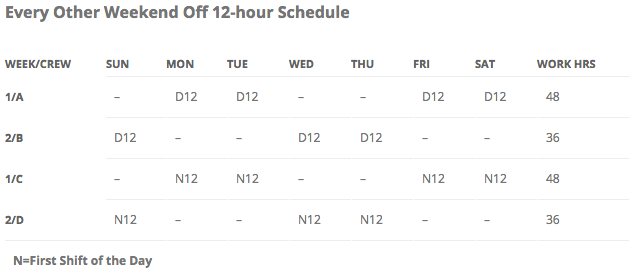In our last schedule update, we addressed the common concern that 12-hour shifts result in reduced alertness and productivity. We showed that while workers on 12-hour shifts got less sleep on the days they worked, they actually got more sleep over time because of the increased number of days off.
In this schedule update, we are going to discuss the sleep issues associated with a popular 12-hour shift schedule. Many of the people who contact us about changing to 12-hour shifts express an interest in getting every other weekend off. Although many 12-hour schedules provide half the weekends off, rarely does this occur precisely every other week. To do that requires a specific schedule called “Every Other Weekend Off” (EOWO). An example of using fixed shifts is shown below.

The way this schedule works is as follows. Four crews staff the schedules. Two crews (A and B) are in the top schedule and two crews (C and D) are in the bottom schedule. The schedules have fixed shifts, which means that the shift workers always work day shift or always work a night shift. In this case, crews A and B work fixed days while crews C and D work fixed nights. When the schedules first start, the crews are assigned to specific weeks in the cycle. For example, on the top schedule, crew A is assigned to start in week 1 and crew B is assigned to start in week 2. At the end of each week, the crew swap weeks into the cycle.
The EOWO schedule is popular among dayshift workers. They only have to work two or three days in a row before getting time off. Every break is at least two days long, and they get a three-day weekend off every other week.
For the night shift, however, the schedule is not always a good choice. Since many nightshift workers revert to a day shift lifestyle on their days off, they switch from sleeping at night to sleeping during the day every 2-3 days. This rapid rotation of sleep times results in inadequate and poor quality sleep.
On a fixed shift schedule such as the one shown above, this can be resolved by adopting a different shift pattern for the night shift. Schedules with fewer blocks of shifts worked per year (e.g., the 4-on-4-off schedule) are best since they require workers to make fewer adjustments to the night shift.
On a rotating shift schedule, the EOWO pattern may be tolerable to some people since the rapid rotation of sleep times occurs two out of every four weeks. Employees who don’t like working the night shift may think this is a great schedule because it only requires them to work two or three night shifts in a row. But they should be reminded of how this will affect their sleep and alertness. This is why it is helpful to have someone available who is thoroughly familiar with different schedules and their lifestyle/health implications whenever planning a schedule change.
It is interesting to note that alertness is the primary issue with organizations that are considering a change to 12-hour shifts. Yet with organizations that already have adopted 12-hour shifts, the biggest issue is open shift management, i.e. how to fill a vacant shift due to an absence (vacations, illness, training, etc.).
With 8-hour shifts, you can have someone stay over to cover the vacant shift (thus working 16 hours), or you can have them stay over for 4 hours and have someone from the following shift come in 4 hours early. With 12-hour shifts, however, you have to call in someone who has the day off. Not only is this a frustrating task for supervisors, but also it can take up a huge amount of their valuable time.
Call Us and We Can Help
Call or text us today at (415) 763-5005 to discuss your operations and how we can help you solve your shift work problems. You can also complete our contact form and we will call you.

